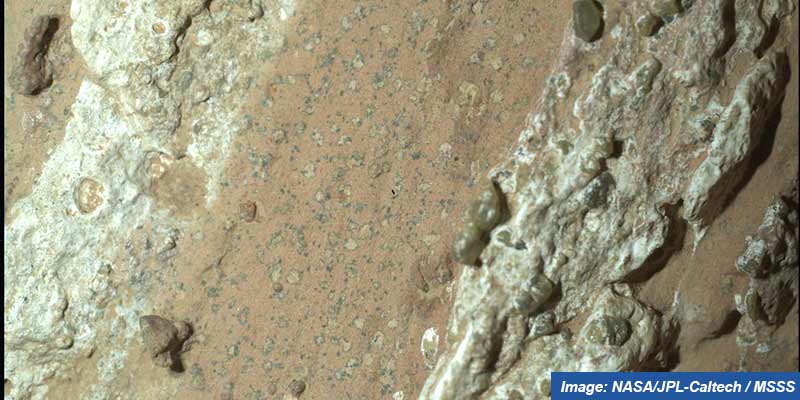- World
- Sep 12
- Sreesha V.M
NASA’s Mars rover finds potential biosignature
• A sample collected by NASA’s Perseverance Mars rover from an ancient dry riverbed in Jezero Crater could preserve evidence of ancient microbial life.
• Taken from a rock named ‘Cheyava Falls’ in 2024, the sample, called ‘Sapphire Canyon’, contains potential biosignatures.
• Sapphire Canyon is one of 27 rock cores the rover has collected since landing at Jezero Crater in February 2021.
• A potential biosignature is a substance or structure that might have a biological origin but requires more data or further study before a conclusion can be reached about the absence or presence of life.
• This was revealed in a paper published in the journal Nature on September 10.
Jezero Crater
• Jezero Crater is located on the western edge of Isidis Planitia, a giant impact basin just north of the Martian equator.
• Western Isidis presents some of the oldest and most scientifically interesting landscapes Mars has to offer. Scientists believe the 45-kilometer-wide crater was home to a lake about 3.5 billion years ago.
• The word “Jezero” in several slavic languages means “lake” – as well as an ancient river delta.
How was the discovery made?
• Perseverance came upon Cheyava Falls in July 2024 while exploring the “Bright Angel” formation, a set of rocky outcrops on the northern and southern edges of Neretva Vallis, an ancient river valley measuring a quarter-mile (400 meters) wide that was carved by water rushing into Jezero Crater long ago.
• The rover’s science instruments found that the formation’s sedimentary rocks are composed of clay and silt, which, on Earth, are excellent preservers of past microbial life. They also are rich in organic carbon, sulfur, oxidised iron (rust), and phosphorous.
• While investigating Cheyava Falls, an arrowhead-shaped rock measuring 3.2 feet by 2 feet (1 meter by 0.6 meters), they found what appeared to be colourful spots.
• The spots on the rock could have been left behind by microbial life if it had used the raw ingredients, the organic carbon, sulfur, and phosphorus, in the rock as an energy source.
• In higher-resolution images, the instruments found a distinct pattern of minerals arranged into reaction fronts (points of contact where chemical and physical reactions occur) the team called leopard spots.
• The spots carried the signature of two iron-rich minerals: vivianite (hydrated iron phosphate) and greigite (iron sulfide).
• Vivianite is frequently found on Earth in sediments, peat bogs, and around decaying organic matter. Similarly, certain forms of microbial life on Earth can produce greigite.
• The combination of these minerals, which appear to have formed by electron-transfer reactions between the sediment and organic matter, is a potential fingerprint for microbial life, which would use these reactions to produce energy for growth.
NASA’s Mars 2020 Perseverance mission
• NASA’s Mars 2020 Perseverance rover mission is the first in a sequence of missions designed to return a scientifically selected suite of Martian rock, regolith and atmosphere samples to Earth for laboratory investigation.
• The Mars 2020 mission spacecraft, carrying the Perseverance rover, was launched from Cape Canaveral, Florida, on July 30, 2020.
• After a nearly seven month journey through space, Perseverance rover successfully touched down on the surface of Mars on February 19, 2021.
• A key objective of Perseverance’s mission on Mars is astrobiology, including caching samples that may contain signs of ancient microbial life.
• The rover will characterise the planet’s geology and past climate, to help pave the way for human exploration of the Red Planet and as the first mission to collect and cache Martian rock and regolith.
• The Mars 2020 Perseverance mission is part of NASA’s Moon to Mars exploration approach, which includes Artemis missions to the Moon that will help prepare for human exploration of the Red Planet.
(The author is a trainer for Civil Services aspirants.)


